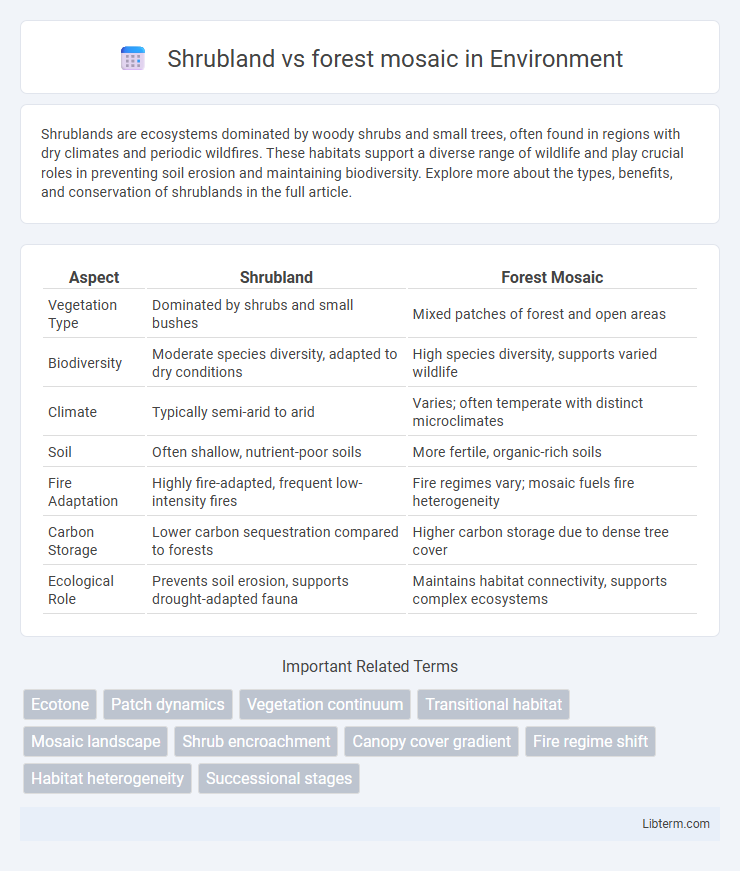Shrublands are ecosystems dominated by woody shrubs and small trees, often found in regions with dry climates and periodic wildfires. These habitats support a diverse range of wildlife and play crucial roles in preventing soil erosion and maintaining biodiversity. Explore more about the types, benefits, and conservation of shrublands in the full article.
Table of Comparison
| Aspect | Shrubland | Forest Mosaic |
|---|---|---|
| Vegetation Type | Dominated by shrubs and small bushes | Mixed patches of forest and open areas |
| Biodiversity | Moderate species diversity, adapted to dry conditions | High species diversity, supports varied wildlife |
| Climate | Typically semi-arid to arid | Varies; often temperate with distinct microclimates |
| Soil | Often shallow, nutrient-poor soils | More fertile, organic-rich soils |
| Fire Adaptation | Highly fire-adapted, frequent low-intensity fires | Fire regimes vary; mosaic fuels fire heterogeneity |
| Carbon Storage | Lower carbon sequestration compared to forests | Higher carbon storage due to dense tree cover |
| Ecological Role | Prevents soil erosion, supports drought-adapted fauna | Maintains habitat connectivity, supports complex ecosystems |
Introduction to Shrubland and Forest Mosaic
Shrubland and forest mosaics are distinctive ecological landscapes characterized by the interspersion of woody shrubs and forest patches, creating diverse habitats that support varied flora and fauna. Shrublands typically feature dense, low-growing vegetation adapted to arid or semi-arid conditions, while forest mosaics consist of fragmented forest stands interspersed with open areas or shrublands, promoting biodiversity and ecological resilience. These dynamic systems play crucial roles in carbon sequestration, soil conservation, and providing habitat connectivity across landscapes.
Key Characteristics of Shrubland Ecosystems
Shrubland ecosystems feature dense, woody shrubs with sparse tree cover, typically adapting to dry, nutrient-poor soils and frequent fire regimes, promoting biodiversity through fire-resistant plant species. These areas display a multi-layered vegetation structure where low shrubs dominate, supporting a unique assemblage of wildlife adapted to open habitats, contrasting with the taller canopy and denser undergrowth of forest mosaics. Shrublands also contribute significantly to carbon sequestration and soil stabilization, making them critical in maintaining ecological balance and mitigating climate change impacts.
Defining Features of Forest Mosaic Habitats
Forest mosaic habitats are characterized by a complex spatial pattern of mixed vegetation types, including patches of trees, shrubs, and open areas that create varied microenvironments. These mosaics support high biodiversity by offering diverse niches and promoting ecological connectivity between forested and shrubland areas. Structural heterogeneity in canopy cover, plant species composition, and soil types distinguishes forest mosaics from uniform shrubland ecosystems.
Biodiversity Comparisons: Shrubland vs Forest Mosaic
Shrubland ecosystems typically support a unique assemblage of drought-tolerant plant species and specialized wildlife adapted to open, sunlit conditions, resulting in moderate biodiversity levels. Forest mosaics combine patches of dense tree cover with shrub-dominated areas, creating diverse microhabitats that enhance species richness, including both forest-dependent and edge species. Comparative studies reveal that forest mosaics generally harbor higher overall biodiversity due to habitat heterogeneity promoting greater ecological niches and species interactions.
Climate and Geographic Distribution
Shrubland vs forest mosaic ecosystems occur predominantly in temperate and Mediterranean climates characterized by seasonal droughts and variable precipitation. These landscapes are widely distributed across regions such as California, the Mediterranean Basin, Australia, and parts of South America, where topography and soil conditions create patchy arrangements of woody shrubs interspersed with forest stands. Climate factors including temperature fluctuations and fire frequency influence the spatial heterogeneity and species composition within these mosaics.
Soil and Hydrology Differences
Shrubland and forest mosaics exhibit distinct soil characteristics, with shrublands typically having thinner, less fertile soils due to lower organic matter inputs and higher erosion rates compared to the richer, more nutrient-dense forest soils. Hydrologically, shrublands often experience quicker surface runoff and reduced water infiltration, leading to lower groundwater recharge, whereas forest mosaics enhance water retention through dense canopy cover and complex root systems that promote soil moisture conservation and sustained groundwater flow. These differences in soil composition and water dynamics significantly influence ecosystem processes, vegetation patterns, and resilience to environmental stressors.
Dominant Flora and Fauna
Shrubland vs forest mosaic habitats feature distinct dominant flora; shrublands are characterized by drought-resistant shrubs such as manzanita and sagebrush, while forest mosaics contain a mix of tree species like oaks, pines, and maples, interspersed with patches of shrubs. Fauna in shrublands typically includes species adapted to open, dry environments such as jackrabbits, coyotes, and quail, whereas forest mosaics support a diverse array of animals including deer, woodpeckers, and foxes that thrive in heterogeneous habitat structures. These ecosystems provide critical ecological functions by supporting biodiversity and offering various niches for specialized plant and animal communities.
Ecological Functions and Services
Shrubland and forest mosaics provide distinct ecological functions, supporting biodiversity by offering varied habitats for flora and fauna, which enhance species richness and ecosystem resilience. These landscapes play critical roles in carbon sequestration, water regulation, and soil stabilization, contributing to climate regulation and reducing erosion risks. The spatial heterogeneity in forest mosaics promotes nutrient cycling and supports pollinator populations, essential for maintaining ecosystem productivity and agricultural benefits.
Human Impact and Land Use Changes
Human impact has significantly altered shrubland and forest mosaic ecosystems through activities such as agriculture, urbanization, and logging, leading to habitat fragmentation and biodiversity loss. Land use changes include the conversion of forest mosaics to monoculture plantations or shrublands to pasturelands, resulting in reduced ecological complexity and resilience. These transformations disrupt carbon sequestration processes and soil stability, exacerbating climate change and land degradation.
Conservation Strategies for Shrubland and Forest Mosaic
Conservation strategies for shrubland and forest mosaic prioritize maintaining biodiversity by protecting native plant species and preventing habitat fragmentation. Implementing controlled burns in shrublands helps reduce invasive species and promotes regeneration, while forest mosaics benefit from selective logging and habitat corridors to sustain ecological connectivity. Monitoring wildlife populations and restoring degraded areas enhance resilience and support ecosystem services critical to both habitats.
Shrubland Infographic

 libterm.com
libterm.com